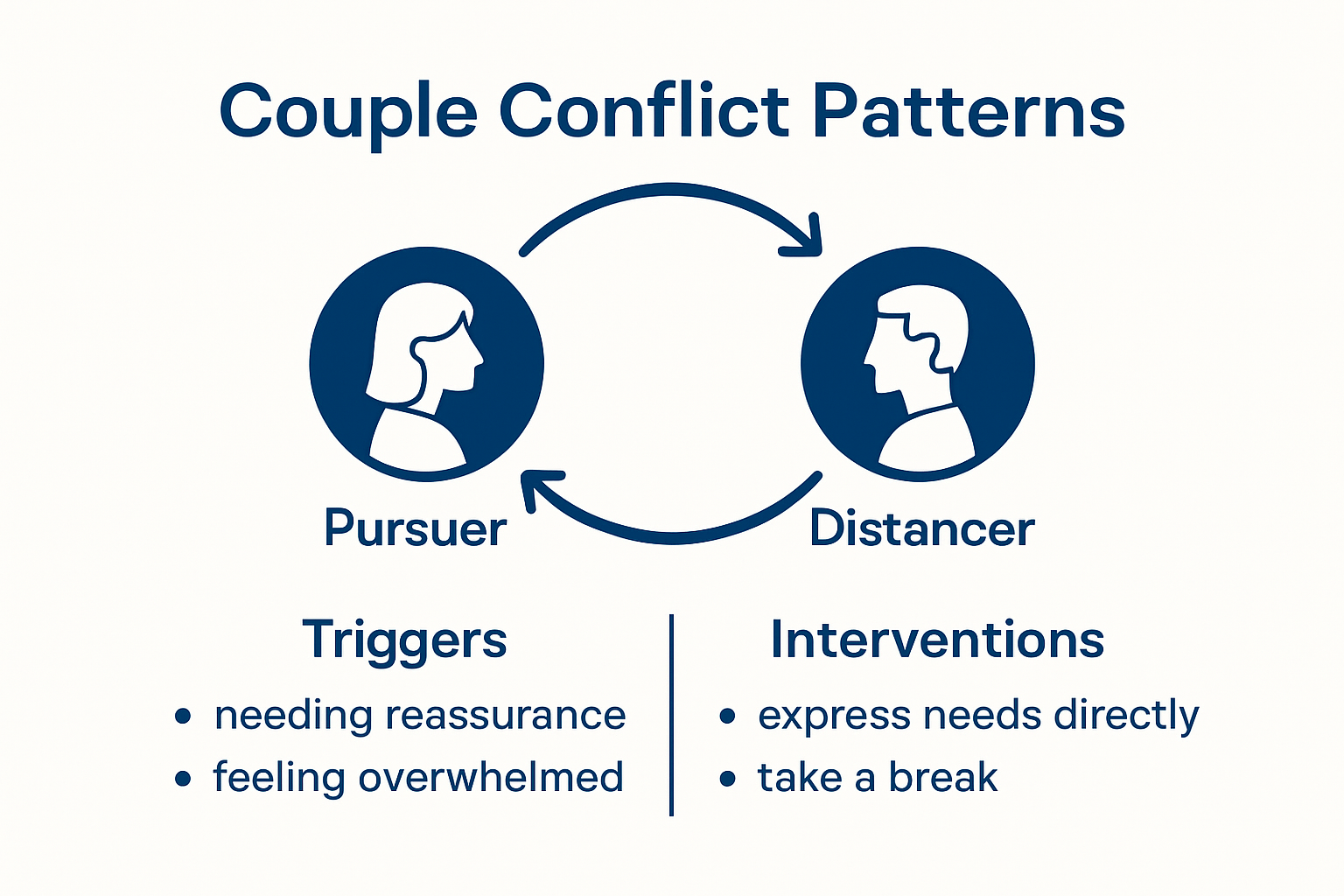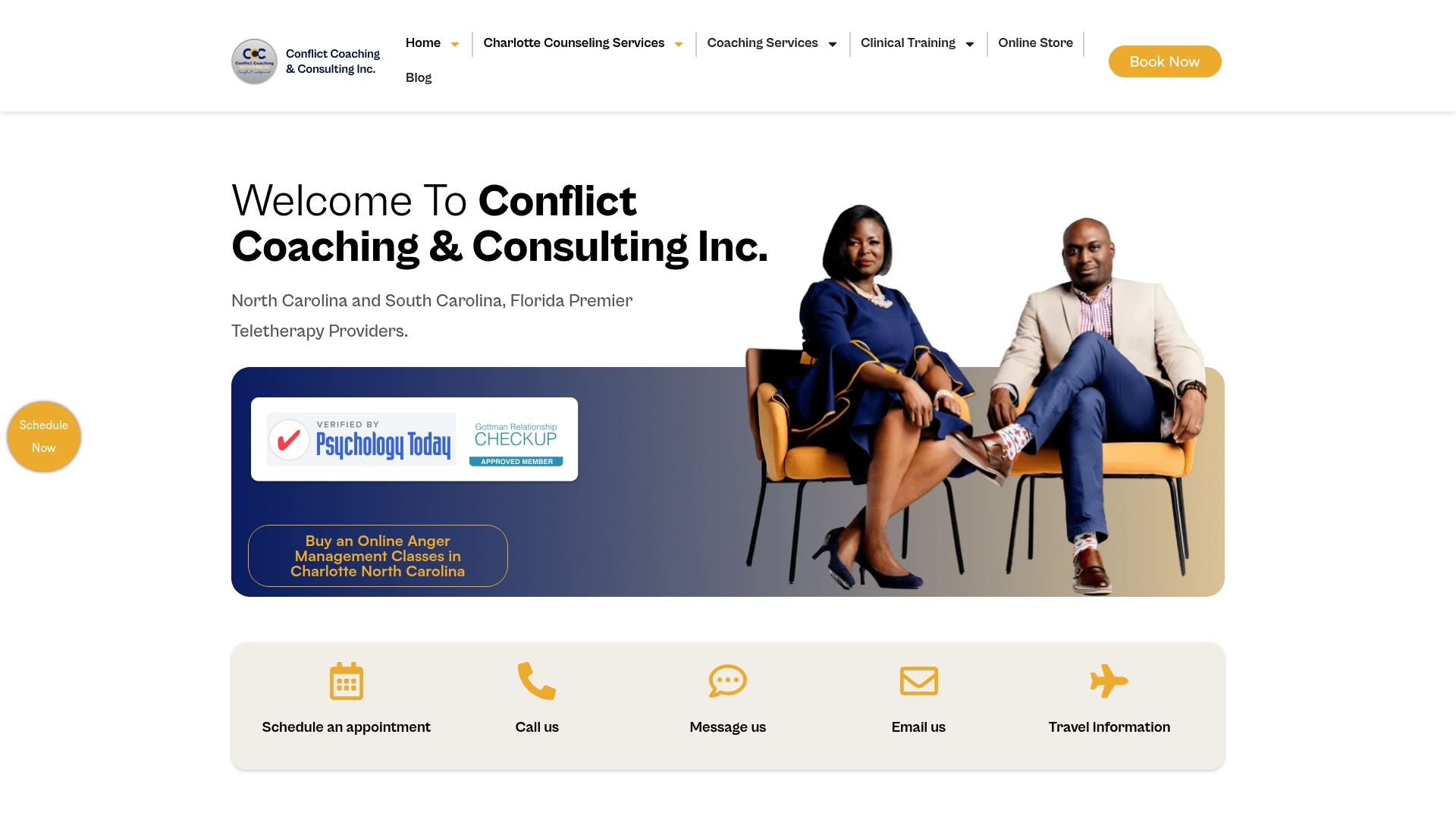Conflict Resolution for Couples: Practical Strategies for 2025

Couples everywhere argue, but most never realize they’re repeating the same arguments in a loop, with little progress each time. Sounds discouraging, right? Yet, fewer than 30 percent of couples can actually name their recurring conflict pattern, which means most people remain trapped on a conflict carousel without even knowing it. Understanding these hidden signatures is the first key to breaking out and changing how couples connect for good.
Table of Contents
- Understanding Conflict Patterns In Couples
- Effective Communication Skills For Partners
- Culturally Responsive Approaches And Community Support
- Teletherapy And Regional Counseling Options
Quick Summary
| Takeaway | Explanation |
|---|---|
| Recognize your conflict pattern | Understanding your unique conflict signature helps identify reactive cycles in your relationship. |
| Practice active listening | Engaging fully with your partner’s emotional experience fosters deeper connection and understanding. |
| Use ‘I’ statements to express needs | Communicating personal feelings reduces defensiveness and promotes collaborative problem-solving in discussions. |
| Create a safe emotional space | Cultivating an environment of respect and understanding encourages vulnerability and better communication. |
| Explore teletherapy options | Teletherapy provides flexible access to professional guidance, enhancing relationship support regardless of location. |
Understanding Conflict Patterns in Couples
Conflict is an inevitable aspect of intimate relationships, yet many couples struggle to recognize and address the underlying dynamics that fuel their disagreements. Understanding these conflict patterns is crucial for developing effective communication and maintaining a healthy relationship.
The Recurring Dance of Relationship Conflicts
Research published in Frontiers in Psychology reveals that couples often fall into predictable negative interaction cycles. These patterns typically emerge as repetitive emotional responses that create a destructive feedback loop. One of the most common dynamics is the pursuer-distancer pattern, where one partner actively seeks connection and resolution, while the other withdraws or becomes emotionally unavailable.
These patterns are not random but deeply rooted in individual attachment styles and past emotional experiences. Partners unconsciously trigger each other’s defense mechanisms, creating a cyclical interaction that can erode relationship satisfaction over time. For instance, a partner who feels anxious about emotional distance might become increasingly demanding, which paradoxically pushes the other partner further away.

Identifying Your Unique Conflict Signature
According to the American Psychological Association, recognizing these patterns is the first step toward meaningful change. Each couple develops a unique “conflict signature” characterized by specific communication styles, emotional triggers, and response mechanisms. Some couples might engage in heated arguments with raised voices, while others experience silent stonewalling and emotional withdrawal.
Understanding your relationship’s conflict pattern requires honest self-reflection and mutual vulnerability. Couples need to step back and observe their recurring interactions without judgment. Are there specific topics that consistently lead to arguments? Do certain words or tones trigger defensive responses? Mapping these patterns helps partners interrupt destructive cycles and develop more constructive communication strategies.
Breaking Negative Interaction Cycles
Interrupting entrenched conflict patterns demands intentional effort and sometimes professional guidance. Emotionally Focused Therapy offers a promising approach by helping couples identify underlying emotional needs driving their interactions. Instead of focusing on surface-level disagreements, this approach helps partners understand the deeper emotional vulnerabilities that fuel their conflicts.
Successful conflict resolution involves transforming these patterns through increased emotional awareness, active listening, and empathetic response. Partners must learn to recognize their automatic reactions and choose more deliberate, compassionate communication strategies. This might involve practicing pause and reflect techniques, where individuals take a moment to understand their emotional state before responding.
If you’re interested in exploring how to navigate relationship conflicts more effectively, our guide on embracing constructive conflict provides additional insights into transforming challenging interactions into opportunities for deeper connection.
Effective Communication Skills for Partners
Mastering effective communication is the cornerstone of healthy relationships, transforming potential conflicts into opportunities for deeper understanding and connection. Unlike common misconceptions, communication is not just about talking but about creating meaningful dialogue that fosters mutual respect and emotional safety.
The Art of Active Listening
Research from the National Institutes of Health reveals that couples who practice intentional listening strategies experience significantly improved relationship satisfaction. Active listening goes beyond merely hearing words it involves fully engaging with your partner’s emotional experience.
Key components of active listening include maintaining eye contact, providing verbal and nonverbal affirmation, and reflecting back what you’ve heard. For example, instead of interrupting or preparing your defensive response, you might say, “What I hear you saying is that you feel unappreciated when I work late. Is that correct?” This approach demonstrates genuine interest and validates your partner’s feelings.
Below is a table summarizing core active listening techniques and their benefits for couples.
| Technique | Description | Benefit |
|---|---|---|
| Maintain Eye Contact | Look at your partner while listening | Builds trust and signals attentiveness |
| Reflect Back | Paraphrase what you heard (“What I hear you saying is…”) | Shows understanding and validation |
| Provide Affirmation | Use verbal (“I see,” “Go on”) and nonverbal (nods) cues | Encourages openness |
| Avoid Interrupting | Let your partner finish speaking before responding | Reduces defensiveness, promotes respect |
| Ask Clarifying Questions | Request more information if needed | Prevents misunderstandings |
Expressing Needs Without Blame
According to the American Psychological Association, effective communication hinges on expressing personal needs using “I” statements rather than accusatory language. This subtle shift can dramatically reduce defensive reactions and create a more collaborative environment.
Instead of saying, “You never help around the house,” a more constructive approach would be, “I feel overwhelmed when household responsibilities seem unbalanced. Could we discuss ways we might share these tasks more equitably?” This method communicates your experience without attacking your partner, inviting problem-solving instead of triggering conflict.
Creating a Safe Emotional Space
Research published in the International Journal of Environmental Research and Public Health emphasizes the importance of creating a safe emotional environment where both partners feel heard and respected. This involves cultivating emotional intelligence, practicing empathy, and maintaining a calm demeanor during challenging conversations.
Emotional safety means creating an atmosphere where vulnerability is welcomed, not punished. Partners should aim to respond with curiosity instead of judgment, seeking to understand each other’s perspectives. This might involve asking open-ended questions, offering compassionate responses, and demonstrating that your partner’s emotions are valid, even when you might disagree.
Additionally, timing matters significantly in communication. Choosing moments when both partners are calm and receptive, rather than attempting complex discussions during high stress or fatigue, increases the likelihood of productive dialogue.
If you’re looking to dive deeper into improving your communication strategies, explore our comprehensive guide on navigating relationship challenges for more targeted insights and practical techniques.

Culturally Responsive Approaches and Community Support
Navigating relationship conflicts requires understanding that cultural background profoundly influences communication, emotional expression, and conflict resolution strategies. Each community brings unique relational dynamics that demand nuanced, respectful approaches to supporting couples.
Cultural Perspectives on Relationship Dynamics
Research examining Mexican-origin couples demonstrates how cultural orientations significantly impact marital interactions and conflict management. Cultural background shapes expectations about gender roles, communication styles, and relationship hierarchies. What might be considered confrontational in one cultural context could be viewed as normal dialogue in another.
These cultural nuances extend beyond simple communication differences. They reflect deep-rooted values, family traditions, and generational experiences that inform how partners perceive conflict, express emotions, and seek resolution. Understanding these contextual layers becomes crucial for developing effective conflict resolution strategies that honor individual and collective cultural identities.
The following table summarizes how cultural backgrounds can impact relationship dynamics and conflict resolution styles, as discussed in the content.
| Cultural Aspect | Possible Impact on Relationship Dynamics | Conflict Resolution Style |
|---|---|---|
| Gender Roles | Shapes household responsibilities, expectations | May influence communication hierarchy |
| Communication Styles | Direct vs. indirect, expressive vs. reserved | Affects openness or confrontation level |
| Family Traditions | Informs values, involvement of extended family | Involves collective or individual focus |
| Generational Values | Influences acceptance of therapy, expression of feelings | May adopt traditional or modern tactics |
Tailoring Support to Diverse Community Needs
A comprehensive study on relational interventions highlights the critical importance of culturally adaptive therapeutic approaches. Generic conflict resolution techniques often fail because they do not account for the rich diversity of cultural communication patterns and relationship dynamics.
Culturally responsive support means creating safe spaces where couples feel understood, respected, and validated. This involves training mental health professionals to recognize and appreciate cultural differences, developing interventions that are flexible and adaptive, and avoiding one-size-fits-all approaches that can inadvertently marginalize certain communities.
Building Inclusive Community Support Networks
Research on support services for diverse populations underscores the significance of community-centered support models. Effective conflict resolution extends beyond individual therapy, requiring robust community networks that provide holistic, culturally informed resources.
These support networks might include community workshops, culturally specific counseling services, peer support groups, and resources that address unique challenges faced by different communities. For immigrant populations, refugees, or marginalized groups, such support can be transformative, offering not just conflict resolution skills but also a sense of belonging and understanding.
Building these networks requires collaboration between mental health professionals, community leaders, cultural organizations, and local support groups. The goal is to create ecosystems of support that recognize and celebrate cultural diversity while providing targeted, compassionate guidance for couples navigating relationship challenges.
Learn more about finding the right professional support for your unique relationship needs and discover how tailored approaches can make a significant difference in your conflict resolution journey.
Teletherapy and Regional Counseling Options
The landscape of couples counseling has dramatically transformed, with technology offering unprecedented access to mental health support across geographic boundaries. Teletherapy has emerged as a powerful alternative to traditional in-person counseling, providing flexible and accessible options for couples seeking relationship guidance.
The Evolution of Virtual Counseling
Research from the National Library of Medicine reveals that 74% of therapists are likely to continue providing teletherapy services post-pandemic. This shift reflects the growing recognition of virtual platforms as effective tools for relationship support. Couples can now access professional guidance from the comfort of their home, breaking down geographical and logistical barriers that previously limited counseling opportunities.
Virtual counseling platforms offer unique advantages, including increased scheduling flexibility, reduced travel time, and the ability to connect with specialists who might not be locally available. For couples in North and South Carolina, Florida, and other regions, this means access to high-quality relationship support regardless of their physical location.
Innovative Technologies in Couples Support
Research exploring technology in relationship counseling highlights emerging approaches that go beyond traditional video conferencing. Cutting-edge technologies like virtual reality are creating immersive therapeutic experiences that can enhance emotional connection for couples, particularly those in long-distance relationships.
A groundbreaking study on loving-kindness meditation in virtual reality demonstrates how advanced technologies can facilitate deeper emotional connections. These innovative approaches are particularly valuable for couples facing unique challenges such as geographical separation, demanding work schedules, or limited local mental health resources.
Navigating Teletherapy Effectively
Successful teletherapy requires intentional preparation and commitment. Couples should establish a private, comfortable space for sessions, ensure reliable internet connectivity, and approach virtual counseling with the same seriousness as in-person therapy. This means minimizing distractions, being emotionally present, and maintaining open communication with both your partner and therapist.
Ethical considerations remain paramount. Couples must verify their therapist’s credentials, understand privacy protocols, and ensure the chosen platform meets professional standards for confidentiality and data protection. Many licensed professionals now offer comprehensive teletherapy services that mirror the depth and effectiveness of traditional counseling approaches.
Explore our comprehensive guide to finding the right therapeutic support to help you make informed decisions about your relationship counseling journey. Whether you’re seeking local in-person support or embracing the flexibility of virtual counseling, understanding your options is the first step toward meaningful relationship growth.
Frequently Asked Questions
What are the common conflict patterns in couples?
Couples often engage in predictable negative interaction cycles, such as the pursuer-distancer pattern, where one partner seeks connection while the other withdraws. Recognizing these patterns is key to addressing conflicts effectively.
How can I improve my communication skills in a relationship?
Practicing active listening, using ‘I’ statements to express needs, and creating a safe emotional space for dialogue can significantly enhance communication between partners, fostering understanding and connection.
What role does culture play in relationship conflict?
Cultural background influences communication styles, expectations about gender roles, and approaches to conflict resolution. Understanding these cultural dimensions can help partners navigate conflicts more effectively.
How does teletherapy support couples in conflict resolution?
Teletherapy offers flexible access to professional guidance, allowing couples to receive support from the comfort of their homes. It eliminates geographical barriers and provides couples with innovative tools to work on their relationships.
Ready to Break the Cycle? Discover Effective Solutions for Your Relationship
Tired of revisiting the same arguments and feeling trapped in harmful conflict patterns with your partner? If the recurring pursuer-distancer dance, miscommunications, or cultural differences described above sound familiar, you are not alone. Many couples struggle to identify their unique conflict signature and lack the tools to create a safe emotional space for true connection. These challenges can leave you feeling frustrated, misunderstood, and hopeless about building a healthier relationship.

Now is the time to take action and move beyond repeating cycles. At Mastering Conflict, you can access specialized couples therapy, anger management programs, and tailored teletherapy options designed to address your specific needs. Ready for deeper change? Visit our online therapy solutions and explore our guide to choosing the right support for your relationship. Don’t wait to transform your approach to conflict—book your confidential session today and start building a more connected future together.
Recommended
- How to Deal With Parenting Conflicts
- 8 Good Reasons Couples Should Embrace Conflict
- 21 Ways to Control Anger in a Relationship
- How to deal with Traits you don’t like in your Partner
- Choosing Travel Companions: Smart Tips for 2025 Adventures – Vacationspotter.com
- codependency Archives – Lighthouse Recovery Institute

9 Responses